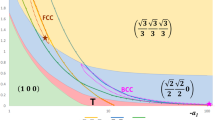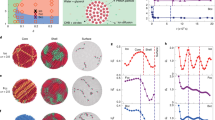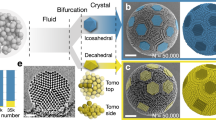Abstract
CRYSTALLIZATION of a solid phase from a melt or solution is a special case of pattern formation in which the dissipation of energy across the free energy gradient between the two phases can give rise to various growth morphologies in the steady state1. Experimental studies of crystallization from undercooled solutions2, electrolytic deposition3,4 and the formation of fluid patterns in a Hele–Shaw cell5 have revealed faceted, dendritic, 'dense-branching' and fractal morphologies6. For a system with fixed anisotropy and interfacial tension, changes in the driving force for the transition (such as the degree of undercooling) can cause changes in growth morphology which are usually accompanied by changes in growth rate. The selection rule that determines these morphologies remains unclear, although a recent suggestion5,6 is that it is based on the growth velocity. Here I propose that selection is governed by the rate of entropy production per unit area of the different growth patterns. This principle allows accurate prediction of the morphology transition observed for the crystallization of NH4CI (ref. 2). I suggest that it may reflect a more general thermodynamic principle underlying a wide range of natural processes.
This is a preview of subscription content, access via your institution
Access options
Subscribe to this journal
Receive 51 print issues and online access
$199.00 per year
only $3.90 per issue
Buy this article
- Purchase on Springer Link
- Instant access to full article PDF
Prices may be subject to local taxes which are calculated during checkout
Similar content being viewed by others
References
Nicolis, G. & Prigogine, I. Self-organization in Nonequilibrium Systems (Wiley-Interscience, New York, 1977).
Chan, S. K., Reimer, H. H. & Kahlweit, M. J. Cryst. Growth 32, 303–315 (1976).
Sawada, Y., Dougherty, A. & Gollub, J. P. Phys. Rev. Lett. 56, 1260–1263 (1986).
Grier, D., Ben-Jacob, E., Clarke, R. & Sander, L. M. Phys. Rev. Lett. 56, 1264–1267 (1986).
Ben-Jacob, E., Garik, P., Mueller, T. & Grier, D. Phys. Rev. A38, 1370–1380 (1988).
Ben-Jacob, E. & Garik, P. Nature 343, 523–530 (1990).
Kahlweit, M. J. Cryst. Growth 6, 125–129 (1970).
Widom, M., Deng, D. P. & Henley, C. L. Phys. Rev. Lett. 63, 310–313 (1989).
Strandburg, K. J., Tang, L-H. & Jaric, M. V. Phys. Rev. Lett. 63, 314–317 (1989).
Maddox, J. Nature 335, 201 (1988).
Hawthorne, F. C. Nature 345, 297 (1990).
Glansdorff, P. & Prigogine, I. Thermodynamics of Structure, Stability and Fluctuations (Wiley-Interscience, New York, 1971).
Author information
Authors and Affiliations
Rights and permissions
About this article
Cite this article
Hill, A. Entropy production as the selection rule between different growth morphologies. Nature 348, 426–428 (1990). https://doi.org/10.1038/348426a0
Received:
Accepted:
Issue Date:
DOI: https://doi.org/10.1038/348426a0
This article is cited by
-
Evolution of cellular morphology in pure materials
Journal of Materials Science (2020)
-
Thermodynamic analysis of thermal convection based on entropy production
Scientific Reports (2019)
-
Is the catalytic activity of triosephosphate isomerase fully optimized? An investigation based on maximization of entropy production
Journal of Biological Physics (2017)
-
The description of morphologically stable regimes for steady state solidification based on the maximum entropy production rate postulate
Journal of Materials Science (2011)
Comments
By submitting a comment you agree to abide by our Terms and Community Guidelines. If you find something abusive or that does not comply with our terms or guidelines please flag it as inappropriate.



